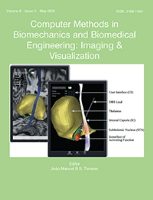
Computer Methods in Biomechanics and Biomedical Engineering-Imaging and Visualization
Scope & Guideline
Pioneering Research in Biomechanics and Imaging Technologies
Introduction
Aims and Scopes
- Computational Modeling in Biomechanics:
The journal extensively covers computational modeling techniques that simulate biological systems and processes, which are crucial for understanding complex biomechanical behaviors. - Medical Imaging Techniques:
A major focus is placed on various medical imaging modalities, including MRI, CT, and ultrasound, with an emphasis on improving image quality and diagnostic accuracy through advanced algorithms. - Machine Learning and AI Applications:
There is a significant emphasis on the application of machine learning and artificial intelligence to enhance diagnostic processes, automate image analysis, and improve patient outcomes. - Innovations in Visualization Techniques:
The journal promotes the development and application of visualization techniques that facilitate the interpretation of complex biomedical data, aiding in both research and clinical practice. - Interdisciplinary Approaches:
The journal encourages interdisciplinary research that combines engineering, computer science, and medical sciences to address complex healthcare challenges.
Trending and Emerging
- Deep Learning and Neural Networks:
There is a surge in research utilizing deep learning techniques for image segmentation, classification, and enhancement across various medical imaging modalities, indicating a shift towards more sophisticated analytical methods. - Telemedicine and Remote Monitoring Technologies:
Recent publications highlight the growing importance of telemedicine and remote monitoring systems, particularly in the context of rehabilitation and chronic disease management, reflecting the ongoing digital transformation in healthcare. - Augmented and Virtual Reality Applications:
The integration of augmented and virtual reality in surgical training and planning is on the rise, showcasing innovative applications that enhance surgical precision and educational effectiveness. - Big Data and Multi-Modal Data Integration:
Emerging themes include the use of big data analytics and multi-modal data integration to improve diagnostic accuracy and personalize treatment plans, emphasizing the need for comprehensive data utilization. - Regenerative Medicine and Bioprinting:
There is an increasing focus on regenerative medicine and bioprinting technologies, which are seen as promising areas for future research and application in surgical and therapeutic contexts.
Declining or Waning
- Traditional Image Processing Techniques:
There has been a noticeable decline in publications focused on traditional image processing methods, as more researchers are gravitating towards machine learning and deep learning approaches that offer superior performance. - Basic Statistical Methods in Medical Research:
Papers utilizing basic statistical methods for medical research analysis appear to be less frequent, likely due to the increased sophistication and capability of modern computational techniques. - Non-AI-Based Diagnostic Tools:
The focus on non-AI-based diagnostic tools has diminished as AI and machine learning methods become more dominant in the literature, reflecting a broader trend towards automation and enhanced accuracy.
Similar Journals
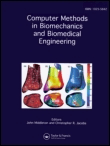
COMPUTER METHODS IN BIOMECHANICS AND BIOMEDICAL ENGINEERING
Elevating Biomedical Engineering with Advanced Computational ResearchCOMPUTER METHODS IN BIOMECHANICS AND BIOMEDICAL ENGINEERING, published by TAYLOR & FRANCIS LTD, is a leading journal dedicated to the interdisciplinary field of biomechanics and biomedical engineering. With an ISSN of 1025-5842 and an E-ISSN of 1476-8259, this journal has been a significant resource since its inception in 1997 and will continue to publish cutting-edge research until 2024. The journal holds a respectable position in the academic community, categorized in Q3 of multiple domains including Bioengineering, Biomedical Engineering, and Human-Computer Interaction, reflecting its relevance across diverse fields. Although the journal does not offer open access, it provides valuable insights and methodologies essential for researchers, professionals, and students engaged in advancing computational techniques and their application in medicine and engineering. With Scopus rankings highlighting its growing influence, particularly in the Biomedical Engineering and Human-Computer Interaction sectors, this journal plays a crucial role in fostering innovation and enhancing the understanding of biomechanical systems through computational methods.

Biomedical Engineering Online
Exploring cutting-edge solutions for modern medical challenges.Biomedical Engineering Online, published by BMC, is an esteemed open-access journal in the United Kingdom that has been advancing the field of biomedical engineering since its inception in 2002. With a commitment to disseminating high-quality research, the journal encompasses a broad scope, including innovative studies in biomaterials, imaging technologies, and medical applications. Recognized within the Q2 quartile for various categories such as Biomaterials and Biomedical Engineering, it ranks favorably among its peers: Rank #58 out of 333 in Radiology, and Rank #15 out of 63 in Radiological and Ultrasound Technology in the Scopus database. These rankings, coupled with an open-access model, ensure that critical advancements in medical technology are accessible to researchers, health professionals, and students globally. As it continues through its converged years from 2002 to 2024, Biomedical Engineering Online remains an invaluable resource for anyone involved in the cutting-edge intersection of engineering and medicine.
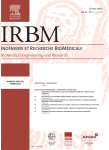
IRBM
Exploring the Frontiers of Biomedical Research and InnovationIRBM, published by Elsevier Science Inc, stands at the forefront of research in the domains of Biomedical Engineering and Biophysics, boasting impressively high rankings with a Q1 category in both fields according to the 2023 evaluations. With an effective focus on cutting-edge innovations and methodologies, IRBM provides a vital platform for researchers, professionals, and students alike seeking to disseminate and access groundbreaking findings and developments. Its strong presence in the Scopus database, with ranks of #12 in Biochemistry, Genetics and Molecular Biology and #42 in Biomedical Engineering, places it in the top percentile of impactful journals in the field, making it a crucial resource for advancing knowledge and fostering collaboration. While the journal maintains a traditional subscription model, it continues to attract a diverse readership eager for insightful studies and reviews that push the boundaries of science and engineering. With a projected convergence of years extending to 2024, IRBM promises to remain a significant contributor to the ongoing dialogue in the life sciences.
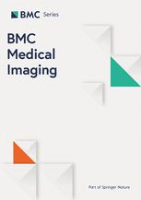
BMC MEDICAL IMAGING
Advancing the Future of Radiology and Imaging Technologies.BMC Medical Imaging is a premier open-access journal dedicated to advancing the field of radiology, nuclear medicine, and imaging technologies. Published by BMC in the United Kingdom, this journal serves as a vital resource for researchers, clinicians, and students, fostering a collaborative environment for sharing innovative findings and methodologies in medical imaging. With a commendable impact factor and an impressive Scopus ranking within the top 35% of its category, BMC Medical Imaging provides a platform for high-quality research to be disseminated widely and freely since its inception in 2001. The journal aims to cover a diverse array of topics, from advanced imaging techniques to their clinical applications, enhancing the understanding and effectiveness of diagnostic practices. By contributing to the body of knowledge and facilitating open access to research, BMC Medical Imaging plays a pivotal role in shaping the future of medical imaging and improving patient care.

Advanced Biomedical Engineering
Elevating research standards in multidisciplinary engineering.Advanced Biomedical Engineering is a peer-reviewed open access journal published by the Japanese Society for Medical & Biological Engineering, dedicated to disseminating high-quality research in the multidisciplinary fields of biomedical engineering. Boasting an ISSN of 2187-5219, this journal has been pivotal since its inception in 2018, especially as it embraces the open access model to foster knowledge sharing and wide accessibility. Centered in Tokyo, Japan, it serves as a vital platform for scholars and practitioners across various domains, such as biomaterials, biomedical engineering, and biotechnology. Despite currently residing in the Q4 quartile across several categories, including those in biotechnology and computer science applications, the journal is committed to elevating its academic impact and reputation, aiming for improved rankings in Scopus and other databases. Researchers and professionals are encouraged to contribute their innovative findings, discussions, and case studies, facilitating the advancement of this dynamic field.
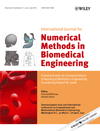
International Journal for Numerical Methods in Biomedical Engineering
Unlocking Potential through Numerical Analysis and EngineeringInternational Journal for Numerical Methods in Biomedical Engineering is a premier peer-reviewed journal dedicated to promoting advancements in numerical methods and their applications in the biomedical engineering field. Published by WILEY and based in the United States, this journal serves as a vital platform for disseminating innovative research from 2010 to 2024, with a focus on bridging the gap between computational techniques and real-world biomedical challenges. With an impressive impact factor and categorized in the Q2 quartile across several fields including Applied Mathematics and Biomedical Engineering, it ranks among the top journals in its domain. The journal provides free access to its content, making it an invaluable resource for researchers, professionals, and students eager to explore groundbreaking methodologies. By fostering interdisciplinary collaboration and showcasing high-quality research, International Journal for Numerical Methods in Biomedical Engineering plays a crucial role in advancing our understanding of complex biomedical systems through numerical analysis.

JOURNAL OF FLOW VISUALIZATION AND IMAGE PROCESSING
Illuminating Fluid Dynamics Through Visual InnovationThe Journal of Flow Visualization and Image Processing, published by Begell House Inc, serves as a pivotal forum for scholars and practitioners in the fields of computer science applications, condensed matter physics, and mechanical engineering. Since its inception in 1996, this journal has been dedicated to advancing the understanding of fluid dynamics through visualization techniques and image processing methodologies. With a publication trajectory extending to 2024, the journal has established a solid reputation, reflected in its Q3 categorization across multiple disciplines as of 2023, indicating its relevance and contribution to current research paradigms. Although it is not an open-access journal, it offers invaluable insights and findings that are critical for researchers, professionals, and students alike who are interested in the complexities of flow phenomena and their applications. The journal's commitment to disseminating high-quality research—despite its current rankings, which show room for improvement—underscores its potential for growth and the vital role it plays in fostering innovation within the scientific community.

IEEE Open Journal of Engineering in Medicine and Biology
Fostering collaboration for a healthier future.IEEE Open Journal of Engineering in Medicine and Biology is a premier Open Access journal published by the esteemed IEEE-INST ELECTRICAL ELECTRONICS ENGINEERS INC, dedicated to advancing the interdisciplinary fields of biomedical engineering and medicine. Since its inception in 2020, the journal has quickly established itself within the academic community, boasting a notable ranking of #49 out of 303 in the Biomedical Engineering category on Scopus and achieving an impressive 83rd percentile. With an objective of disseminating high-quality research and innovative developments that bridge engineering and medical sciences, the journal is committed to fostering collaboration among researchers, healthcare professionals, and policymakers. Operating with Open Access since 2020 allows for wider accessibility and dissemination of cutting-edge findings, promoting the exchange of knowledge vital for tackling contemporary challenges in health technology. As the journal continues to grow through to 2024, it remains a vital resource for anyone invested in the enhancement of medical technology and the betterment of patient care.

JOURNAL OF MATHEMATICAL IMAGING AND VISION
Unveiling the Geometry of Vision through MathematicsJOURNAL OF MATHEMATICAL IMAGING AND VISION, published by Springer, stands as a significant platform for advancing the fields of applied mathematics, computer vision, and pattern recognition, among others. With an ISSN of 0924-9907 and an E-ISSN of 1573-7683, this esteemed journal is based in the Netherlands and has been contributing to the scholarly discourse since its inception in 1992, with a converged focus through 2024. It has achieved reputable standings within several quartiles, including Q2 rankings across applied mathematics, geometry and topology, and condensed matter physics, reflecting its impact and relevance. Notably, the journal ranks within the top 5% in Geometry and Topology and maintains robust standings in Statistics and Probability. The JOURNAL OF MATHEMATICAL IMAGING AND VISION is dedicated to publishing high-quality research that bridges theoretical perspectives with practical applications, making it an essential resource for researchers, professionals, and students who are exploring the cutting-edge of mathematical imaging and its interdisciplinary applications.

Biomedical Physics & Engineering Express
Empowering Healthcare through Open-Access ResearchBiomedical Physics & Engineering Express, published by IOP Publishing Ltd, serves as a dynamic platform for the dissemination of groundbreaking research in the interdisciplinary domains of biomedical physics, engineering, and related fields. With a focus on innovative solutions for healthcare challenges, the journal extends its reach to a global audience, providing valuable insights that influence both academic research and practical applications. Operating under an open-access format, this journal ensures that vital scientific discoveries are readily available to researchers, professionals, and students alike. Ranking within the Q3 and Q4 quartiles across various categories—including Bioengineering and Biomedical Engineering—indicates its emerging influence in the scientific community since its inception in 2015. With an increasing footprint in Scopus rankings and a commitment to advancing knowledge in subfields such as biophysics and health informatics, Biomedical Physics & Engineering Express plays a crucial role in shaping future innovations in healthcare technology and patient care.